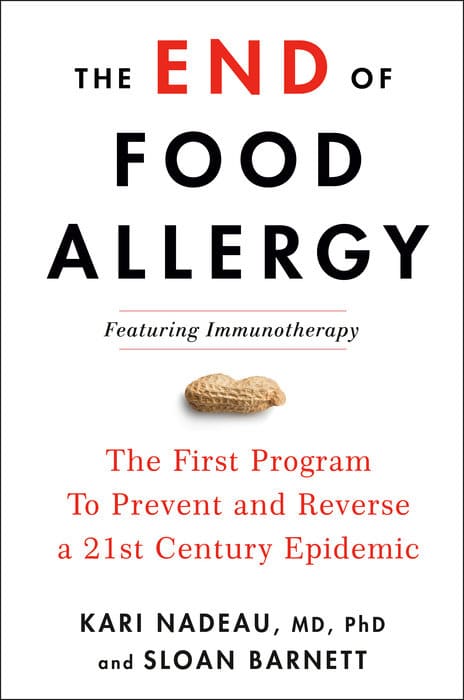Given that food allergies have soared worldwide for decades and now afflict roughly two children per American classroom, the title of the latest book on this topic will strike some as an overreach. The heart of “The End of Food Allergy,” by Kari Nadeau and Sloan Barnett, is better captured on its final page: “The new era of food allergy is all about empowerment. There is no reason to live in fear and isolation anymore.”

BOOK REVIEW — “The End of Food Allergy: The First Program To Prevent and Reverse a 21st Century Epidemic,” by Kari Nadeau and Sloan Barnett (Avery, 352 pages).
In the United States, 32 million people — about one in 10 – have food allergies. Shellfish, milk, and peanuts are the top culprits, but more than 170 foods have caused allergic reactions. Peanut and tree nut allergies tripled in children between 1997 and 2008. And in a survey last year, nearly half of food-allergic adults reported developing allergies to foods they had eaten safely as children.
Allergic reactions crop up unpredictably and can be life-threatening, so living with food allergies can feel a bit like navigating the global pandemic: Taking precautions all the time gets burdensome. For food allergy sufferers, the vigilance required to avoid accidental exposures is “the background hum of worry that becomes the soundtrack of life,” the authors write. Sometimes, they note, managing food allergies can make people downright fearful, as though “living with the constant threat of your home bursting into flames.”
Nadeau is a pioneer in treating food allergies with immunotherapy, an approach that carefully introduces small amounts of allergens into the body. She directs the Sean N. Parker Center for Allergy and Asthma Research at Stanford University. Barnett is a New York Times best-selling author whose food-allergic children were treated through Nadeau’s program. With interviewing and fact-checking help from science journalist Jessica Wapner, the team brings clarity and compassion to a confusing condition. The book shines a light on less-discussed psychological aspects of food allergies and distills research that has rewritten prevention guidelines and is paving the way to immunotherapy and other treatments.
“The End of Food Allergy” is meticulously researched, interspersing scores of studies (their citations fill 38 pages) with everyday experiences of those who struggle with the disease — for example, the rush of terror felt by an 11-year-old boy at the doctor’s office doing an oral food challenge, and the surprising relief, after swallowing a peanut M&M, when he discovers he was not in fact allergic to a food he had spent his whole life avoiding.
The first section offers potential reasons for the global rise in food allergies and explores the evidence (or lack thereof) for some of those nagging questions parents have — can mom’s diet during pregnancy or breastfeeding influence the likelihood of baby’s food allergy? What about having a C-section or using certain types of formula?
The second part traces the groundswell of research that overturned recommendations on introducing allergens to babies; describes pivotal studies that opened doors to immunotherapy (IT); and offers a glimpse at other drugs, devices, and technologies on the horizon. The main focus is a regimen called oral immunotherapy (called “OIT”), in which patients ingest increasing amounts of the allergen daily over a period of months to raise the body’s threshold to the food. Less-researched types of immunotherapy that involve under-the-tongue drops or adhesive skin patches are discussed more sparingly. (In her 2018 book, “The Food Allergy Fix,” private allergist Sakina Bajowala describes how she treats patients with both oral and under-the-tongue forms of immunotherapy at her Illinois clinic.)
The final section examines the emotional toll of food allergies — the anxiety and stress that seem invisible but often weigh more heavily on families than the allergic reactions themselves. “For so many parents, the fear of offering an infant that first tiny bite of egg pales in comparison to the fear of a peanut-allergic elementary school student on a class trip or a wheat-allergic teenager heading to a friend’s house on pizza-making night,” the authors write. Food allergies can “leave a child feeling left out or stigmatized” and “leave parents fretting and overprotective.”
The book includes plenty of practical tidbits — such as reminders that labeling laws only cover the top eight allergens, and the assurance that epinephrine, the emergency drug given to stop serious reactions, typically remains stable for about two years after its expiration date. On the science, the authors cover a lot of research but don’t get bogged down in minutia or medical jargon. Their storytelling will engage motivated readers, even those who barely remember high school biology.
Nadeau and Barnett make a notable effort to portray science realistically — not as a clear-cut picture but a messy, evolving process. They summarize decades of discovery showing how research can be painfully incremental, often with unclear or confusing results. “We believe that equipping people with information means presenting as complete a picture as we can,” they write.
Occasionally research proves that expert assumptions were flat-out wrong — as was the case with earlier misguided advice from pediatricians who suggested holding off on feeding babies dairy until 1 year of age, eggs until 2 years, and peanuts and other potentially allergenic foods until 3 years.
Summary charts recap conclusions from hard-to-interpret findings, and each chapter closes with a set of bullet-point takeaways highlighting the best available evidence. For example, the chapter on infant feeding concludes by advising parents to feed babies peanuts and other common allergens early and often, starting around 4 to 6 months of age, to lower their risk of food allergies.
In keeping with mainstream medicine’s recognition that there’s no one-size-fits-all approach to managing food allergies, the book rarely dispenses straight-up advice. Rather, the authors offer grounding principles that equip readers to think for themselves as they puzzle over diagnostic test results and sort through potential treatment options.
Such guidance can help readers balance hope with healthy skepticism in buyer-beware situations. The “money to be made from the food allergy ‘market’ — that is, people living with the condition — is reason for caution,” the authors write. Recognizing this is especially important when sussing out therapies in a divided field whose practitioners differ in what they endorse and offer. Reasons for the divisiveness are complex. The book gives historical context — explaining, for example, how a rift initially developed between food allergy specialists and the allergy field at large — and offers some perspective on why only a small but growing number of allergists today offer immunotherapy for food allergies.
Medicine “as a practice is cautious by nature,” the authors write. “Health care professionals want evidence. They want to see the data and an FDA-approved product first.”
At present, the only FDA-approved food allergy treatment is Palforzia, given to children who are allergic to peanuts — the most common childhood food allergen. A set of capsules containing peanut flour, Palforzia is administered using procedures published by academic centers that received government funding for oral immunotherapy studies in the 2000s.
But with food allergy rates rising, a small number of allergists took “matters into their own hands” about a decade ago, the authors write. Guided by the published academic methods, these allergists started offering OIT at private clinics — not just for peanut allergy but other foods as well.
Experts have not reached a consensus on the best treatment protocols. Since many OIT clinics use commercial food products, which have variable contents, the authors caution that “rigorous evidence justifying the techniques used in a private setting may be lacking.” For now, key challenges remain: access, cost, insurance coverage, a rare gastrointestinal complication (eosinophilic esophagitis), and uncertainty about how to maintain unresponsiveness to allergens.
On the whole, though, the book is optimistic. “The attention paid to food allergy is light-years beyond where it once was,” Nadeau and Barnett write. “Picture a world in which everyone who wants to become desensitized to a food allergen can be — that’s the world we are working toward.”
Esther Landhuis is a California-based science journalist who writes about biomedicine and STEM diversity. Her stories have appeared in Scientific American, NPR, Nature, and Quanta, among other publications. She has spoken with dozens of families and allergists while reporting on food allergies for Undark, Real Simple, and elsewhere. She can be reached on Twitter at @elandhuis.











Comments are automatically closed one year after article publication. Archived comments are below.
There should also be a section on the psychological impacts of long-term OIT: treatment fatigue, comparable incidence to anaphylaxis with OIT to avoidance therapy, and no clear research to determine what minimum dose would make a patient save from accidental ingestion. I have a 13yo that has been in maintenance OIT for 3+ years. Trust me it’s no easy feat to have to eat your allergen every morning without fail. The cure has its serious, serious downsides as well–not quite as rosy as one would believe.